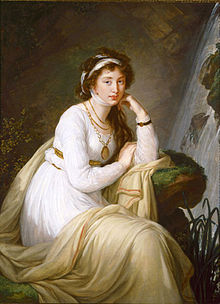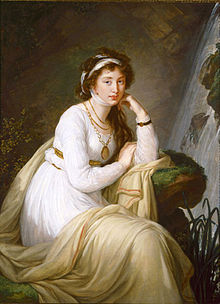Daughter of Prince Ivan Baryatinsky, the ambassador in Paris, and Princess Catherine Petrovna Holstein-Beck of Oldenburg, Princess Baryatinskaya held a high position in the world, to get to her house was considered a great honor, to the same wealth allowed her to live well and lush. Poet Ivan Dolgorukov was a frequent guest of Princess Baryatinskaya, he participated in performances of her home and took care of her daughter, Anna. In 1787, Anna became the wife of Count Nikolai Alexandrovich Tolstoy. Since his appointment in May 1793 at the great chamberlain of Alexander I of Russia, Anna was presented to the court.
Beautiful and cute, for withdrawal of his cousin Varvara Golovina, and the shy and silent Countess Tolstoy quickly became a member of the most intimate circle at the Grand Duke's court. Since that time, her close friendship with the young Grand Duchess Elizabeth Alexeyevna, who affectionately called her la longue (long), as Anna was very tall.
Family life of Countess Anna Ivanovna was not happy. After a strong grief associated with the death in 1797 of her youngest daughter Eudoxia between her and her husband quarrel occurred. Anna fell in love with the English envoy Charles Whitworth, 1st Earl Whitworth, which was quite indifferent to it, but very often visited her house for intrigue and blind. At the same time he was in open communication with Olga Zherebtsova and led the planned conspiracy against the emperor Paul I of Russia, with Nikita Petrovich Panin and Admiral José de Ribas. Count Tolstoy, all the time to see the result of which they were constant quarrels between the couple. Soon intrigue with Charles Whitworth, 1st Earl Whitworth was discovered, and the emperor asked the British government's removal of the ambassador, and as Paul I of Russia claim was satisfied, Charles Whitworth, 1st Earl Whitworth left Saint Petersburg. Along with him went abroad Countess Anna Tolstoy.
Jealousy of her husband, with a quick temper and his unbridled nature, severe domestic scene led Anna Ivanovna decide to leave. With great difficulty, procured by his brother, under the mediation of mistress Ivan Kutaisov, actress Madame Chevalier, the consent of the emperor to depart abroad, she left in 1800 to his mother in Berlin. But soon the Countess Tolstoy was disappointed in her feelings to Charles Whitworth, 1st Earl Whitworth, and in April 1801 in London he married the Duchess of Dorset. His marriage discovered it, in her own words, eyes to the abyss into which it was ready to use.
After Paul I of Russia's death, at the request of the Empress Elizabeth Alexeyevna Countess Tolstoy returned to Russia to her husband. She was present at the coronation of Tsar Alexander I of Russia in Moscow, but soon again went abroad with the children and has traveled extensively in Europe. However, Anna did not break off relations with Russia and its relations with the empress, it remains a close friend. Letters to her Empress published in 1909 by Grand Duke Nikolai Mikhailovich.
Countess Tolstoy friendship with the French emigrant, Louise Emmanuel de Chartillon, Princess de Tarant, and communication with others in Saint Petersburg Catholic world had its effect on Anna Ivanovna: she converted to Catholicism among many women, the highest Saint Petersburg circle. This change of religion, however, forced Countess Tolstoy to go abroad. She settled in Florence on his own villa. Count Felix Golovkin wrote in November 1816 from Italy:
Princess Gagarin close friend of my niece Tolstoy, their associates Catholicism. They are led by secular women, departed from the Orthodox Church, and was the cause of careless ardor expulsion of the Jesuits from Russia. Here, where they are free to worship the God of Rome, they observe utmost restraint, and in St. Petersburg, they dreamed of martyrdom as an Italian dream of lovers. They are led by secular women, departed from the Orthodox Church, and was the cause of careless ardor expulsion of the Jesuits from Russia. Here, where they are free to worship the God of Rome, they observe utmost restraint, and in Saint Petersburg, they dreamed of martyrdom as an Italian dream of lovers.
Widowed in December 1816, Countess Tolstoy died in Paris on April 12, 1825 and was buried in the cemetery Le Calvaire du Mont-Valerien.
Daughter of Prince Ivan Baryatinsky, the ambassador in Paris, and Princess Catherine Petrovna Holstein-Beck of Oldenburg, Princess Baryatinskaya held a high position in the world, to get to her house was considered a great honor, to the same wealth allowed her to live well and lush. Poet Ivan Dolgorukov was a frequent guest of Princess Baryatinskaya, he participated in performances of her home and took care of her daughter, Anna. In 1787, Anna became the wife of Count Nikolai Alexandrovich Tolstoy. Since his appointment in May 1793 at the great chamberlain of Alexander I of Russia, Anna was presented to the court.
Beautiful and cute, for withdrawal of his cousin Varvara Golovina, and the shy and silent Countess Tolstoy quickly became a member of the most intimate circle at the Grand Duke's court. Since that time, her close friendship with the young Grand Duchess Elizabeth Alexeyevna, who affectionately called her la longue (long), as Anna was very tall.
Family life of Countess Anna Ivanovna was not happy. After a strong grief associated with the death in 1797 of her youngest daughter Eudoxia between her and her husband quarrel occurred. Anna fell in love with the English envoy Charles Whitworth, 1st Earl Whitworth, which was quite indifferent to it, but very often visited her house for intrigue and blind. At the same time he was in open communication with Olga Zherebtsova and led the planned conspiracy against the emperor Paul I of Russia, with Nikita Petrovich Panin and Admiral José de Ribas. Count Tolstoy, all the time to see the result of which they were constant quarrels between the couple. Soon intrigue with Charles Whitworth, 1st Earl Whitworth was discovered, and the emperor asked the British government's removal of the ambassador, and as Paul I of Russia claim was satisfied, Charles Whitworth, 1st Earl Whitworth left Saint Petersburg. Along with him went abroad Countess Anna Tolstoy.
Jealousy of her husband, with a quick temper and his unbridled nature, severe domestic scene led Anna Ivanovna decide to leave. With great difficulty, procured by his brother, under the mediation of mistress Ivan Kutaisov, actress Madame Chevalier, the consent of the emperor to depart abroad, she left in 1800 to his mother in Berlin. But soon the Countess Tolstoy was disappointed in her feelings to Charles Whitworth, 1st Earl Whitworth, and in April 1801 in London he married the Duchess of Dorset. His marriage discovered it, in her own words, eyes to the abyss into which it was ready to use.
After Paul I of Russia's death, at the request of the Empress Elizabeth Alexeyevna Countess Tolstoy returned to Russia to her husband. She was present at the coronation of Tsar Alexander I of Russia in Moscow, but soon again went abroad with the children and has traveled extensively in Europe. However, Anna did not break off relations with Russia and its relations with the empress, it remains a close friend. Letters to her Empress published in 1909 by Grand Duke Nikolai Mikhailovich.
Countess Tolstoy friendship with the French emigrant, Louise Emmanuel de Chartillon, Princess de Tarant, and communication with others in Saint Petersburg Catholic world had its effect on Anna Ivanovna: she converted to Catholicism among many women, the highest Saint Petersburg circle. This change of religion, however, forced Countess Tolstoy to go abroad. She settled in Florence on his own villa. Count Felix Golovkin wrote in November 1816 from Italy:
Princess Gagarin close friend of my niece Tolstoy, their associates Catholicism. They are led by secular women, departed from the Orthodox Church, and was the cause of careless ardor expulsion of the Jesuits from Russia. Here, where they are free to worship the God of Rome, they observe utmost restraint, and in St. Petersburg, they dreamed of martyrdom as an Italian dream of lovers. They are led by secular women, departed from the Orthodox Church, and was the cause of careless ardor expulsion of the Jesuits from Russia. Here, where they are free to worship the God of Rome, they observe utmost restraint, and in Saint Petersburg, they dreamed of martyrdom as an Italian dream of lovers.
Widowed in December 1816, Countess Tolstoy died in Paris on April 12, 1825 and was buried in the cemetery Le Calvaire du Mont-Valerien.
Family Members
Advertisement
See more Tolstoy or Baryatinskaya memorials in:
- Le Calvaire du Mont-Valerien Tolstoy or Baryatinskaya
- Suresnes Tolstoy or Baryatinskaya
- Departement des Hauts-de-Seine Tolstoy or Baryatinskaya
- Île-de-France Tolstoy or Baryatinskaya
- France Tolstoy or Baryatinskaya
- Find a Grave Tolstoy or Baryatinskaya
Records on Ancestry
Sponsored by Ancestry
Advertisement




